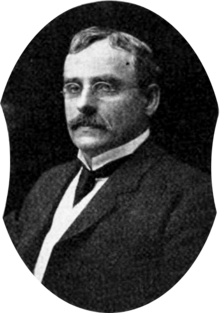Albert Joseph Wallace | |
|---|---|
 | |
| 25th Lieutenant Governor of California | |
| In office January 3, 1911 – January 5, 1915 | |
| Preceded by | Warren R. Porter |
| Succeeded by | John Morton Eshleman |
| Member of the Los Angeles City Council from the 5th ward | |
| In office December 13, 1906 – December 10, 1909 | |
| Preceded by | George A. Smith |
| Succeeded by | District eliminated |
| Personal details | |
| Born | February 11, 1853 Mount Ephraim, Ohio |
| Died | February 23, 1939 (aged 86) Los Angeles, California |
| Political party | Republican |
Albert Joseph Wallace (February 11, 1853 – February 23, 1939) was a member of the Los Angeles, California, City Council in 1907–09 and lieutenant governor of California in 1910–14.
Personal
[edit]
Wallace was born on February 11, 1853, in Wellington County, Ontario, the son of Donald Wallace of Scotland and Harriet Lasby of England. He had nine siblings—John D., George, Francis S., Alexander H., Charles L., Frank S., Lavinia M., Matilda H. and Mary A. Albert Joseph was educated at Victoria University, Toronto. He moved to Pasadena, California, in 1886 and to Los Angeles in 1898.[1][2][3]
Wallace was a University of Southern California regent in 1887 and received an honorary doctor of laws degree from that school in 1912.[1] He was president of the California Anti-Saloon League and of the Los Angeles YMCA board of directors. He was identified with the development of the Methodist Church in Southern California.[2] In 1907 Wallace was elected one of the four vice presidents of the International YMCA convention in Washington, D.C.[4]
His first wife was Serena Healy, who died in childbirth on June 19, 1882. His second was Grace Alice Clark of Worcester, Massachusetts, whom Wallace met in Pasadena while she was vacationing there. They were married in Worcester about 1888, and after she moved to Los Angeles she became a charter member of the Ebell Club. They had four children, Kenneth Clark, Donald J., Helen Harriot and Katherine. She died on July 6, 1913.[5] His third wife was Grace Hagar Wallace.[2][6]
Wallace died at the age of 86 on February 23, 1939, in his home, 631 North McCadden Place in Hancock Park, Los Angeles.[2][7] His survivors were identified in his Los Angeles Times obituary as his widow, Mrs. Grace H. Wallace; two sons, Kenneth C. Wallace of Los Angeles and Donald H. Wallace of Long Beach; two daughters, Mrs. Helen Davis of Brooklyn, New York, and Mrs. Katherine Shannon of Bedford, Pennsylvania, and a sister, Mrs. S.F. Johnson of Pasadena. A funeral service was conducted at the First Hollywood Methodist Church, with interment at with interment at Rosedale Cemetery.[2]
Grace H. Wallace died on September 3, 1939.[8]
Vocation
[edit]Wallace was a teacher between 1869 and 1872, and he was a Methodist minister from 1872 to 1878. He was later the president of the Kendon Petroleum Company.[1] When he lived in Pasadena he and his brother, Frank S. Wallace, were "identified with the early real estate development of the city." After moving to Los Angeles in 1898 he organized "several oil companies."[2] He was a partner in the Ontario Water Company,[9] and he was a director of the Euclid Oil Company, which proposed to "own and develop oil, water and mining claims."[10] Other oil companies he helped organize were the Marengo and the Traders.[11] As a Los Angeles real estate investor, he acquired the Bumiller Building from Isabelle M. Anderson, 1935, in exchange for his two-story building at 425 South Broadway, occupied by the W. T. Grant Company.[12]
Public service
[edit]
Wallace was named a member of the board of trustees of the University of Southern California in 1895 and was board president from 1924 to 1927.[2] On December 4, 1906, he was elected from the 5th Ward as a Republican and nonpartisan to a three-year term on the Los Angeles City Council by a vote of 2,453 for Wallace against 629 for Naelle, his Democratic opponent.[13][14]
He was elected Lieutenant Governor of California in 1910, serving from 1911 to 1915, during Hiram Johnson's first term. In 1921 Wallace was a candidate for the Republican nomination for U.S. Senator, but he was defeated in the primary by Samuel Shortridge.[2]
Notes and references
[edit]- ^ a b c ""Regents of the University of California," University of California History". Archived from the original on 2015-03-05. Retrieved 2014-06-28.
- ^ a b c d e f g h "Veteran State Leader Passes," Los Angeles Times, February 24, 1939, page A-12
- ^ Peter Ross, History of Long Island: From Its Earliest Settlement to the Present Time, New York (1903), Volume III, Pages 95-96, 114
- ^ Associated Press, "Angeleno Honored by International Y.M.C.A.," Los Angeles Herald, November 24, 1907
- ^ "Third Stroke Proves Fatal," Los Angeles Times, July 7, 1913
- ^ "Mrs. A.J. Wallace, Wife Lieutenant Governor, Dead," San Francisco Call, July 7, 1913
- ^ Location of the Wallace home on Mapping L.A.
- ^ "Vital Record," Los Angeles Times, September 5, 1939, page 16
- ^ "Incorporation," Los Angeles Herald, May 30, 1899
- ^ "Incorporations," Los Angeles Herald, August 7, 1900
- ^ "Incorporations," Los Angeles Herald, July 12, 1907
- ^ Building sells for $700,000. Los Angeles Times (Los Angeles, California) Tue, Dec 24, 1935
- ^ "Harper Next Mayor," Los Angeles Times, December 5, 1906, page 2
- ^ Chronological Record of Los Angeles City Officials 1850–1938, Municipal Reference Library, March 1938, reprinted 1946
